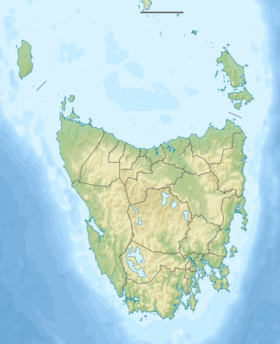North Esk River
| North Esk (lakekeller; mangana[1][2]) | |
| River | |
| North Esk River from Victoria Bridge in Launceston | |
| Country | Australia |
|---|---|
| State | Tasmania |
| Region | Northern Tasmania |
| Part of | South Esk River |
| Tributaries | |
| - right | Ford River, St Patricks River |
| Source | Ben Nevis |
| - location | Northallerton Valley |
| - elevation | 547 m (1,795 ft) |
| Mouth | South Esk River |
| - location | Launceston |
| - elevation | 0 m (0 ft) |
| - coordinates | 41°43′16″S 147°13′06″E / 41.72111°S 147.21833°ECoordinates: 41°43′16″S 147°13′06″E / 41.72111°S 147.21833°E |
| Length | 86 km (53 mi) |
| [3] | |
The North Esk River is a major perennial river located in the northern region of Tasmania, Australia.
Location and features
It is one of the tributaries of the Tamar River together with the South Esk River. It starts in the Northallerton Valley below Ben Nevis in the states North East, joining with the St Patricks River before flowing through Launceston. Launceston's Old Seaport tourist feature is located on the North Esk River. The river becomes tidal downstream of Hoblers Bridge to where it meets the Tamar. It is sometimes subject to flooding, especially in East Launceston suburbs.
The largest tributary of the North Esk is the St Patricks River, with others including the Ford River which flows from the skifields of Ben Lomond and down stream of the Corra Linn Gorge, the Roses Rivulet and Distillery Creek.
The famous Australian beer factory Boags draws its water from St Patricks River
History
Indigenous history
The North Esk River formed part of the traditional lands of the Tasmanian Aborigines. The upper reaches of the river, and its watershed, was the country belonging to the Ben Lomond Nation and the lower reaches, near Launceston was the country of the Leterremairrener clan of the North Midlands Nation.[4] The indigenous names for the North Esk River were lakekeller (with the suffix kila meaning deep) and mangana, which simply means river.[1][2]
European history
The North Esk river area has a forgotten history inside Launceston's cultural memory. The East and West banks were once swarming with Bushrangers and Aboriginal tribes which would continuously attack the settlers of this area. Further up the river, just beyond the first substantial bend known to some then as 'Vermont' bend, there used to be a Punt which was active before Hobler's Bridge was built at what is now St. Leonards in 1829 by George Hobler of 'Killafaddy' (1823). The area of North Esk was once an Electoral district. Many notable Tasmanian gentlemen farmers have lived on the North Esk throughout time. Some properties of historical interest still stand on the banks of the river such as 'Braemar' (1821) and 'Vermont' (1819) just outside Launceston. Convicts were used up until the early 1850s to drain the river flats after it was cultivated so it would not deteriorate back into a swamp after flooding. The river was also the main port facility for Launceston until the construction of the Charles Street Bridge.
On the south bank between the Seaport and Victoria Bridge (southern end of Invermay Road) were numerous wharves dating right back to settlement. These wharves were used by the flour mills, breweries, woolsheds and the Mt Mischoff Tin Smelters. Opposite, on the north bank, were more wharves accessible via Lindsay Street that used to support a rail mounted Gantry Crane which was used to directly load and unload railcars. Upstream were yet more smaller wharves with one of the furthest upstream being the Dynamite Wharf for the magazine reserve and shooting range. Located on Launceston's Glebe Flats, these isolated buildings include an explosives bunker (1850s/1890s) detonator sheds (1850s), a powder magazine and 2 identical ordnance sheds (1914). These buildings are located as a compound and served the military right through to the Second World War. The site is now located on agricultural land and belongs to 49 Boland Street. All the buildings are heritage listed but are yet to be used for any tourist ventures.
See also
References
- 1 2 Plomley, Brian (1992). Tasmanian Aboriginal Place Names. Hobart: QVMAG. p. 17.
- 1 2 Taylor, John (1996). "Dictionary of Palawa place names". State Library of Tasmania/Riuwanna - UTAS: 51.
- ↑ "Map of North Esk River, TAS". Bonzle Digital Atlas of Australia. 2015. Retrieved 18 June 2016.
- ↑ Ryan, Lyndall. asmanian Aborigines : a history since 1803 (2 ed.). Crows Nest: Allen & Unwin. ISBN 1742370683.
